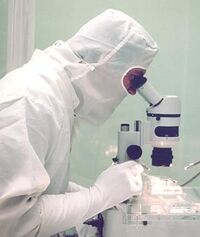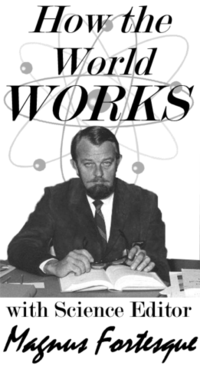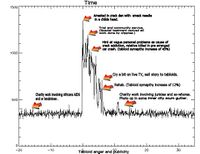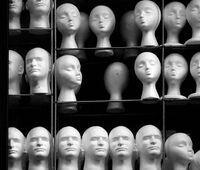Celebrity Manufacture
Celebrity manufacture is a multi-billion dollar industry, worth so much that its real value can't even fit on a calculator. The reason for this is simple: without celebrities no one would buy anything. I certainly know I wouldn't touch any product, tinned or otherwise, unless someone on television said they'd eaten it first. Market research has shown that without celebrities no one would feel safe buying any product. They probably wouldn't even be sure what a product was. Without someone with immaculate teeth and heavily airbrushed skin to point them in the right direction, people would see a tin of spaghetti as a twisted pasta snake pit, Coca Cola would be as popular as arsenic, and people would spread butter on credit cards then eat them like plastic crackers.
Four years ago the advertising industry held a special exercise to find out what would happen in the event of celebrity extinction. This doomsday scenario showed their initial backup plan — which involved using glass beads and other shiny objects to lure shoppers towards products — just wouldn't work. It attracted giant swarms of magpies, but no people. Without someone to tell them what to buy, it was found the public would rather buy nothing. In fact, they seemed happy to wander around like medicated lemmings bumping into each other and falling off cliffs.
As you can see, the consequences of a celebrity shortage just don't bear thinking about. That's why there are over twelve thousand factories worldwide, working endlessly on the designing and breeding of A-list celebrities. It's estimated that every minute at least 8000 celebrities will need to be produced just to keep the stock market from total meltdown, panic buying and executives trying to kill each other with tools in a frenzied attempt to sell everything they've ever owned.
Production
But how do they make celebrities – in test tubes? With hammers? With some sort of futuristic test tube hammer?
No. Far from being glamorous, the truth is surprisingly grubby and mundane. Apparently, they battery-farm them like bloated chickens; they even feed them the same millet seed. Now that might sound like Auschwitz, but it's not: there aren't any guard towers, Germans or typhus! You have to realize that celebrities aren't people – they're a commodity, like soap or cheese. Not many people know this, but you can actually buy stocks in them; I have a controlling stake in Nicole Kidman shares. I don't care that there were originally eight thousand Nicole Kidmans in a giant shed and that she was the only survivor (she ate the others when the millet seed pipe became blocked with a dead rat). We're not dealing with a case of morality here. It's a case of supply and demand. Society wants hollow pointless mannequins to whore their products with, and companies like 'Bainbridge Media Enterprises' supply them...
Scandal Planning
Bainbridge Media Enterprises is Britain's largest manufacturer of celebrities. Their factory contains over eight hundred laboratories producing 47 test tube babies a minute. They employ over 2000 creative consultants here; these frazzled hacks are used to design the pre-packaged personalities for these 'people' and to write a script of every word they will ever say. Virtually every detail of their lives is planned in well in advance: for example, there is a special scandal chart for each of them detailing exactly when and where they'll be caught with a prostitute, unmasked as gay or arrested for shoplifting. Nothing is left to chance. Not even the shoplifting, they actually allow companies to bid for the products the celebrity will try to steal. In the past they've even had offers from hand gun companies looking for publicity who've asked for a particular celebrity to go on a killing spree with their latest range of pistols. Killing has been found to be the most effective form of advertisement, with sales increasing directly in proportion with the body count. That might sound psychotic, but the graphs don't lie.
Violence Sells
In fact, David Beckham was recently scheduled to turn up at Harrods with a bag of machine guns and take 47 hostages, whom he would have then executed over a period of seven days with various weapons (mostly Remington and Colt – they were providing the biggest share of sponsorship). Of course the whole thing would have been broadcast live on QVC. He'd have explained the various benefits of each weapon; Noel Edmonds was going to co-host. He knows what he's doing; we've seen him kill before. It could have been a huge success, but there were problems, and sadly the whole deal eventually fell through. It happened for a number of reasons: he had trouble reading the autocue, he's not really a natural salesman or psychopath. He didn't really have the right persona to control 40 hostages; I mean, I can't really see him shouting: "Get on the floor, you bastards! I'll decorate the walls with your face!"
Thought Costs Money
This need for advertisers to have celebrities do what they want when they want it, from shaking hands with Ronald McDonald to mass murder with a smile, is the reason why celebrities are deliberately engineered not to think. This is done using special microwaves which boil their minds into a watery brain soup, like a sort of intellectual gruel. This is later drained out with a straw, packaged and sold to orphans, so nothing goes to waste. The logic behind this is simple:
- "If you bought a car, would you want it to argue with you? This is the same thing. These people are vehicles for products. We can't allow them to crash into a wall and then cash in on the insurance. We have contracts with Nike and Coca Cola. What's more important, profit or thinking? I think we all know the answer to that. Thinking has never bloated anyone's bank balance."
Much time and effort also goes into external appearance; celebrity plastic surgery is meticulously planned years in advance, with models of different faces being tested in wind tunnels to come up with the ultimate celebrity head. An aerodynamic head is a popular head; market research shows that the less wind resistance a head has the more likely it is to sell skin cream and sun glasses.
In general, designing people is surprisingly easy and mundane. Tom Cruise was designed automatically by a special computer program. Britney Spears's personality was scribbled on the back of an envelope as a spider diagram.
Originally she was no more intelligent than a microbe, a particularly illiterate microbe that couldn't write its own name, and which married its own sister. However, even that was – by celebrity standards – an insane level of intelligence and eventually needed to be scaled down quite a lot.
Mediocrity is Profit
However, there have been problems. Protesters object to the growing of babies in giant test tubes to supply camera fodder for the popular press. Last month they picketed the factory for four days, and had to be driven off with tear gas and beaten into small fleshy lumps. The industry for the most part remains dismissive of their criticism – one designer told me:
- "This company may be morally bankrupt, but it's financially successful, and that's what these people are really appalled by; they're jealous failures... and twits."
He then explained that he doesn't enjoy using babies, but he has no choice until scientists invent something better:

- "If we could make them out of plastic, we would. We wouldn't be here fucking around with babies and test tubes if that was the case. Our ideal celebrity would actually be a sort of living mannequin that you can decorate with product logos and store in a filing cabinet. Our researchers are working on it now, and when it finally comes through it's going to make merchandising much easier. The action figures will just be miniatures of the real people, we'll use the same molds just scaled down. You'll actually be able to keep them as pets. It's going to be great."
While visiting the factory I was taken on a tour of their production line; first I went to see the media acclimatization room. Here, four-year-olds are acclimatized to press conferences: rows of mannequins are used to represent the press and carefully synchronized lights mimic the hypnotic flash of cameras.
- "In here is talent aversion therapy, this is vital."
In this room high voltage electric shocks are used to teach children to avoid things like Mozart and Shakespeare, while encouraging them to like Ronald McDonald and low-grade crack.
We then entered one of the vast storage sheds where children mill around like dwarfish, screaming cattle. My guide pointed to a small, dribbling child with a cookie:
- "This one's going to die in a smack scandal."
I was told that governments often engage in bidding wars to decide which drug a celebrity will die from as part of their war on drugs campaigns. They can even choose the type of vomit a celebrity will choke on; there are color charts with over 8000 different shades of sick. They say the most popular color is something called 'acidic spew'. He then pointed out another child:
"Over here is our replacement for James Dean; we've even got a car ready."
He took me to their vast underground garage full of sports cars, and showed me the cut brake cables; it's all very impressive and immaculately planned. "We're writing the coroner's report next week," he tells me. "We're going to leave a question mark over whether he was full of scotch and acid at the time. Or if the CIA killed him." It's all incredibly fascinating and wonderfully cynical:
- "The babies are worth less than shit." He informed me, "We burn them sometimes if they really try our patience." He even offered to show me the furnace; I declined as there were far more interesting things to see.
Drugs! Drugs! Drugs!
Later I was shown another sterile room full of children:
- "Here's where we help them build up a cocaine tolerance."
Apparently the drug tolerance has to be exceptionally high, as when the time comes for a tabloid scandal they're pumped full of industrial quantities of smack using special hoses and let loose into the streets to dribble and scream.
- "We're actually working on a heroin vaccine so we can have them back to work the next day, once the papers have gotten the exposé photos. We poached some scientists from a cancer research program; we stopped them working on that crap, gave them enough cash to crush their morals and got them to help us. That cancer cure thing was a complete waste of time; it's never going to happen. Plus, we need cancer: it sells papers. I have twenty-three celebrities scheduled to get cancer in the next 12 years; what am I going to do if they cure it? I've paid for the headlines, and the 'My battle with cancer' articles are already written."
Before I left, I asked the tour guide how he thought celebrity manufacturing would advance in the future. Apparently they're working on a way to create heads which can change shape into different logos, like some sort of strange, fleshy play-dough. They're also developing a way to make celebrities transmit adverts telepathically straight into people's skulls. Personally, I can't wait.
See also
| Featured version: 28 October 2007 | |
| This article has been featured on the main page. — You can vote for or nominate your favourite articles at Uncyclopedia:VFH. | |




